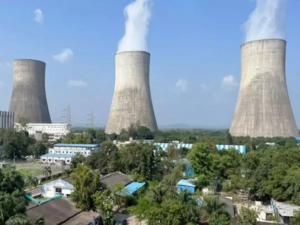| UPSC Relevance Prelims:Atomic Energy Act, 1962,CLNDA, 2010,Pressurised Heavy Water Reactor (PHWR) vs. Light Water Reactor (LWR) Mains:GS Paper 3 – Energy and Infrastructure |
Why in News?
In the Union Budget 2025–26, the Indian government announced a target of 100 GW of nuclear power capacity by 2047, a massive jump from the current 8.18 GW. This marks a strategic shift in India’s clean energy roadmap, aligning with the vision of Viksit Bharat by 2047 and net-zero emissions by 2070.

Background: India’s Nuclear Legacy
India was an early starter in nuclear research:
- In 1956, Apsara became Asia’s first nuclear research reactor.
- By 1963, work began on India’s first nuclear power reactors in Tarapur.
- Homi Bhabha envisioned 8 GW nuclear capacity by 1980, but geopolitical hurdles slowed progress.
Challenges faced:
- Global isolation after the 1974 Peaceful Nuclear Explosion.
- Export controls post-India’s refusal to join the Nuclear Non-Proliferation Treaty (NPT).
- Delays in indigenising reactor technology, especially for Pressurised Heavy Water Reactors (PHWRs).
Despite the Nuclear Suppliers Group (NSG) waiver in 2008 and Indo-U.S. nuclear cooperation, growth remained sluggish due to civil liability laws and lack of private investment.
Nuclear Power: A Necessity for Energy and Climate Goals
To become a developed economy
India must undergo significant economic transformation, requiring massive expansion in infrastructure and energy.
- India’s GDP must rise from $4 trillion to $35 trillion
- Per capita income should grow from $2,800 to $22,000
- This necessitates a five-fold increase in electricity production to support economic growth and urbanisation.
- Electricity consumption (2022): 1,208 kWh/person
Compared to: China – 4,600, USA – 12,500
Current status (2024)
While installed power capacity is growing, actual generation still depends heavily on fossil fuels due to the intermittency of renewables.
- Installed capacity: 480 GW
- Power mix: ~50% renewables and 50% fossil fuels
- But coal still provides 75% of actual electricity generation due to intermittent supply from renewables like solar and wind.
Why Nuclear?
Nuclear energy offers a clean, reliable source of base-load power with a long operational life, making it crucial for energy security and decarbonization.
- Provides baseload power (continuous and reliable, unlike solar or wind)
- Has a lifecycle of 50–60 years, reducing replacement costs
- Emits zero carbon during operation, aiding in climate targets
Global Endorsement
India’s commitment to nuclear aligns with global trends, as seen in the collective pledge to scale up nuclear energy at COP28.
- At COP28 in Dubai (2023), 22 countries including India backed a pledge to triple nuclear capacity by 2050
New Budget Announcements and Plans
100 GW Nuclear Target by 2047
This target forms a core pillar of India’s twin goals: becoming a Viksit Bharat (developed country) by 2047 and achieving net-zero emissions by 2070.
- It marks a major expansion from the current 8.18 GW capacity.
- Nuclear will play a central role in clean base-load power generation.
₹20,000 Crore Allocated for Small Modular Reactors (SMRs)
A dedicated fund under the Nuclear Energy Mission to develop indigenous nuclear innovation.
- Objective: Develop at least five SMRs by 2033
- SMRs are compact, factory-built reactors, designed for scalability and faster deployment.
Strategic Importance of SMRs
SMRs are intended to:
- Replace 100 GW of existing captive thermal power plants used by industries
- Be mass-manufactured, which will help in:
- Lowering capital costs
- Reducing commissioning time
- Improving safety and operational flexibility
Challenges in Nuclear Sector Expansion
1. Legal and Regulatory Reform Needed
The Atomic Energy Act, 1962 must be amended to allow private and foreign participation.
The Civil Liability for Nuclear Damage Act (CLNDA), 2010 places supplier liability, discouraging foreign reactor suppliers.
Key concerns include:
- Can private firms operate reactors?
- Who manages the nuclear island (reactor core)?
- Who is liable for fuel supply, waste management, and accidents?
2. Tariff Regulation and Commercial Disputes
Nuclear tariffs are governed by the Atomic Energy Act, not the Central Electricity Regulatory Commission (CERC).
The NPCIL–Gujarat Urja case exposed gaps in tariff-setting authority.
What’s needed:
- Clearly defined levelised tariff mechanism
- Proper dispute resolution mechanisms to protect private investment
3. Need for an Independent Nuclear Regulator
The Atomic Energy Regulatory Board (AERB) lacks statutory independence and functions under the Department of Atomic Energy.
A 2011 Bill to make it a legally autonomous body was not passed.
Why it’s critical:
Private sector entry requires a neutral and credible safety watchdog to build public and investor confidence.
4. Technology Access and Indigenous Capability Gaps
India still relies on foreign collaboration for advanced reactor designs, especially for Light Water Reactors (LWRs) and Small Modular Reactors (SMRs).
Challenges:
- Delays in technology transfer
- Limited domestic capacity to design and mass-produce reactors
- Dependence on fuel supply agreements with other countries
5. Public Perception and Land Acquisition Issues
Nuclear plants often face local opposition due to safety concerns (e.g., Fukushima) and radiation fears.
Issues faced:
- Protests and resistance to new projects (e.g., Kudankulam, Jaitapur)
- Delays in land acquisition due to environmental and displacement concerns
- Need for transparent communication and community engagement

Pathways for Implementation
✅ Standardise and Mass-Produce Indigenous Designs
India should focus on scaling proven reactor models like the 220 MW Pressurised Heavy Water Reactors (PHWRs) for Small Modular Reactors (SMRs).
The ongoing expansion of 700 MW PHWRs—as seen at Kakrapar—shows the technical readiness and operational safety of indigenous models, which can now be mass-produced to meet rising energy demand.
✅ Accelerate Foreign Collaborations
To bridge the technology and capacity gap, India needs to revive stalled international partnerships:
- France’s Jaitapur project and U.S.-based Westinghouse deal remain on hold due to liability issues.
- Only Russia’s Kudankulam reactors progressed as their agreement predated the CLNDA (2010).
Renewed diplomacy and liability clarity could unlock these critical capacities.
✅ Public–Private Joint Ventures
India is now exploring joint ventures (JVs) to mobilise capital and accelerate construction:
- The revived NTPC–NPCIL JV will install 4×700 MW PHWRs at Mahi Banswara (Rajasthan).
- A new partnership with Rural Electrification Corporation (REC) is also under consideration, showing a shift towards blended public-private financing for nuclear projects.
Financial Incentives and FDI Considerations
To Attract Investment:
- Allow FDI up to 49% to retain Indian control.
- Offer tax incentives and green finance instruments.
- Reclassify nuclear as renewable for subsidy eligibility.
- Encourage long-term power-purchase agreements and viability-gap funding.
(Viability Gap Funding (VGF) is a government grant aimed at supporting infrastructure projects that are economically desirable but commercially unviable. It bridges the gap between project costs and revenue potential, encouraging private sector investment, particularly in public-private partnership (PPP) models through competitive bidding.)
Way Forward: Building a Nuclear Future
To realise its 100 GW target by 2047, India must:
- Open the sector decisively to domestic and foreign private players.
- Amend outdated laws and align tariff mechanisms with other power sectors.
- Ensure safety and regulatory independence, boosting investor and public confidence.
- Integrate nuclear in India’s green taxonomy, unlocking global climate finance.
Conclusion
India’s nuclear sector is at an inflection point. With strong political will, bold regulatory reforms, and active private participation, the dream of 100 GW nuclear capacity by 2047 is not just feasible but necessary. In the battle against climate change and energy poverty, nuclear power can be India’s game-changer.
| Mains pyqs Q. Discuss the role of nuclear energy in meeting India’s future energy needs. Examine the challenges in the expansion of nuclear power in India.(2022) Practice question Q. “India’s ambition of 100 GW nuclear power capacity by 2047 hinges not only on technology but also on enabling legislative, financial and regulatory reforms.” Discuss. (250 words) |
| Key Prelims Facts- Current nuclear power capacity: 8.18 GW India’s first nuclear reactor: Apsara (1956) CLNDA Year: 2010 Kudankulam Reactors: VVER-1000 from Russia Target by 2047: 100 GW nuclear capacity Net Zero Target: 2070 COP26 Announcements: 500 GW non-fossil, 45% carbon intensity reduction |
SOURCE- THE HINDU
Found this helpful?
Bookmark for revision, Practice the mains question, and
Share with fellow aspirants! THANK YOU
